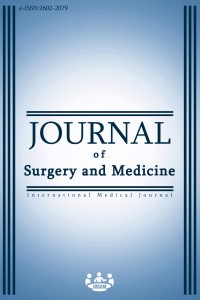Hemodiyaliz ile ürik asit düzeyindeki değişim oranı ile diyaliz yeterliliği arasındaki ilişki
Diyaliz yeterliliği, Üre kinetik model, Kt/V, Ürik asit
The relationship between dialysis adequacy and the rate of change in uric acid level by hemodialysis
Dialysis adequacy, Urea kinetic model, Kt/V, Uric acid,
___
- 1. Levey AS, Eckardt KU, Tsukamoto Y, Levin A, Coresh J, Rossert J, et al. Definition and classification of chronic kidney disease: a position statement from Kidney Disease: Improving Global Outcomes (KDIGO). Kidney Int. 2005;67(6):2089-100.
- 2. Meert N, Schepers E, De Smet R, Argiles A, Cohen G, Deppisch R, et al. Inconsistency of reported uremic toxin concentrations. Artif Organs. 2007;31(8):600–11.
- 3. Vanholder R, Meert N, Schepers E, Glorieux G, Argiles A, Brunet P, et al. European Uremic Toxin Work Group (EUTox) : Review on uraemic solutes II—variability in reported concentrations: causes and consequences. Nephrol Dial Transplant. 2007;22(11):3115–21.
- 4. Vanholder R, De Smet R, Glorieux G, et al. Review on uremic toxins: classification, concentration, and inter individual variability. Kidney Int. 2003;63(5):1934-43.
- 5. Heinig M, Johnson RJ. Role of uric acid in hypertension, renal disease, and metabolic syndrome. Cleve Clin J Med. 2006;73(12):1059-64.
- 6. Chen W, Roncal-Jimenez C, Lanaspa M, Gerard S, Chonchol M, Johnson RJ, et al. Uric acid suppresses 1 alpha hydroxylase in vitro and in vivo. Metabolism. 2014 Jan;63(1):150-60.
- 7. Sampol J, Dussol B, Fenouillet E, et al. High adenosine and deoxy adenosine concentrations in mononuclear cells of hemodialyzed patients. J Am Soc Nephrol. 2001;12(8):1721-8.
- 8. Simmonds HA, Cameron JS, Morris GS, et al. Purine metabolites in uraemia. Adv Exp Med Biol. 1987;223:73-80.
- 9. European Best Practice Guidelines Expert Groupon Hemodialysis, European Renal Association. Section II. Hemodialysis adequacy. Nephrol Dial Transplant. 2002;17(7):16–31.
- 10. Makita Z, et al. Efficiency of removal of circulating advanced glycosylation end-product sand mode of treatment in patients with ESRD. Am Soc Nephrol. 1992;3:335.
- 11. Eloot S, Torremans A, De Smet R et al. Kinetic behavior of urea is different from that of other water-soluble compounds: thecase of the guanidin ocompounds. Kidney Int 2005;67(4):1566–75.
- 12. Kalil RS, Carpenter MA, Ivanova A, et al. Impact of Hyperuricemia on Long-term Outcomes of Kidney Transplantation: Analysis of the FAVORIT Study. Am J Kidney Dis. 2017;70(6):762-9.
- 13. Zuo T, Liu X, Jiang L, Mao S, Yin X, Guo L et al. Hyperuricemia and coronary heart disease mortality: a meta-analysis of prospective cohort studies. BMC Cardiovasc Disord. 2016;16(1):207.
- 14. Braga F, Pasqualetti S, Ferraro S, Panteghini M. Hyperuricemia as risk factor for coronary heart disease incidence and mortality in the generalpopulation: a systematic review and meta-analysis. Clin Chem Lab Med. 2016;54(1):7-15.
- 15. Vanholder RC, De Smet RV, Ringoir SM: Assessment of urea and other uremic markers for quantification of dialysis adequacy. Clin Chem. 1992;38:1429–36,
- 16. De Smet R, Dhondt A, Eloot S, et al. Effect of the super-flux cellulose triacetate dialyser membrane on the removal of non-protein-bound and protein-bound uraemic solutes. Nephrol Dial Transplant. 2007;22(7):2006–12.
- 17. Fagugli RM, De Smet R, Buoncristiani U, et al. Behavior of non-protein-bound and protein bound uremic solutes during daily hemodialysis. Am J Kidney Dis. 2002;40(2):339–47.
- 18. Basile C, Libutti P, Lucia A, Casino G.F, Vernaglione L, Tundo S, et al. Removal of uraemic retention solutes in Standard bicarbonate haemodialysis and long-hours low flow bicarbonate haemodialysis. Nephrol Dial Transplant. 2011; 26(4):1296-303.
- 19. Vanholder R, DeSmet R, Lesaffer G. Dissociation between dialysis adequacy and Kt/V. Semin Dial. 2002;15(1):3-7.
- 20. Fotbolcu H, Duman D, Ecder SA, Oduncu V, Cevik C, Tigen K, et al. Attenuated cardiovascular response to sympathetic system activation during exercise in patients with dialysis-induced hypotension. Am J Nephrol. 2011;33(6):491-8.
- 21. Aon MA, Cortassa S, Maack C, et al. Sequential opening of mitochondrial ion channels as a function of glutathione redox thiol status. J Biol Chem. 2007;282(30):21889-900.
- 22. Shinzato T, Miwa M, Nakai S, et al. Role of adenosine in dialysis-induced hypotension. J Am Soc Nephrol. 1994;4:1987-94.
- Başlangıç: 2017
- Yayıncı: Selçuk BAŞAK
Rektus kılıfından kaynaklanan atipik yerleşimli leiomyom olgusu
Pediatrik hastalarda hidrostatik redüksiyon ile başarılı intususepsiyon tedavisi: Her şey tamam mı?
Yaşlı bir erkekte prostat biyopsisi sonrası gelişen zor ve nadir iki komplikasyon
Tuğba TURGUT, Deniz MUT SÜRMELİ, Remzi Bahşi, Hande Selvi Öztorun, Murat Varlı
İntravenöz immünoglobulin tedavisine hızlı yanıt veren Sitomegalovirüs miyokarditi
Mehmet TÜRE, Hasan BALIK, Meki BİLİCİ, Alper AKIN, Savaş Mert DARAKCİ, Sercan Yücel YANMAZ
Postmenapozal kadınlarda koklear fonksiyona osteoporozun etkisi: Gözlemsel bir çalışma
Saime SAĞIROĞLU, Tuba Tülay KOCA
Venöz staz ülseri olan bir hastada Klippel Trenaunay sendromu
Kevser TURAL, Zeynep BİLGİ, Ceyhun COŞKUN
Sağlıklı, HIV negatif bir hastada bukkal mukozada oral kıllı lökoplaki
Gülhan GÜREL, Sevinç ŞAHİN, Betül AYTEKİN, Emine ÇÖLGECEN
Ankilozan spondilitte bilirubin parametrelerinin klinik önemi: Vaka kontrol çalışması
Tuba Tülay KOCA, Gözde Yıldırım ÇETİN, Hasan GÖĞEBAKAN, Vedat NACİTARHAN
Endoskopik retrograd kolanjiyopankreatografide kanülasyon başarısızlığı önlenebilir mi?
Yahya Kemal ÇALIŞKAN, Mustafa Uygar KALAYCI
Ercan AKŞİT, Çoşkun BAKAR, Özgür ÖZERDOĞAN, Özge TURGAY YILDIRIM, Fatih AYDIN, Ayşe HÜSEYİNOĞLU AYDIN, Bahadır KIRILMAZ, Emine GAZİ, Ali DUYGU
